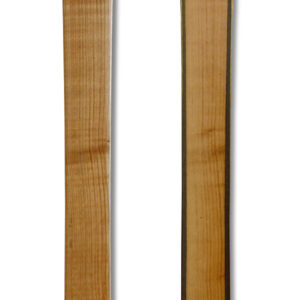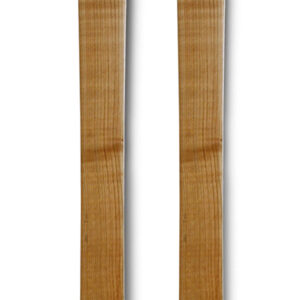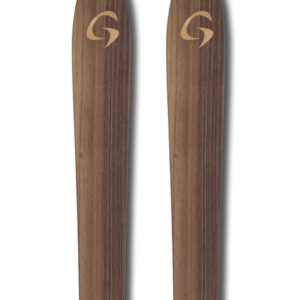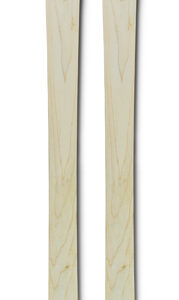Product Description
The limited edition ski model ‘Arctic Change’ is a special, luxury ski based on the construction and shape of the model UpTurn.
The ski is made from exclusive materials from the Arctic – coal from mines in Spitsbergen, reindeer antlers from Svalbard, birch burl wood veneer and Tundra juniper from Lapland. This ski is available in two lengths with a width under foot of 74mm on special order only.
The Arctic Change is available in our online store and in selected stores from January 2014.

The Arctic Change is an exclusive ski telling the story of change in the vulnerable Arctic, supporting conservation and raising awareness for the protection and sustainable use of the unique Arctic wilderness.
The Arctic is one of the last remaining real wilderness on Earth – extremely beautiful, extremely dangerous, and extremely vulnerable. The Arctic is confronted with and threatened by increasing human activity and by climate change, bringing more and more people into the wild – for resource extraction, research and tourism – affecting local indigenuos communities and their traditional way of life, and leading to changes in the ecosystems. A decrease in sea ice cover, melting glaciers, altered migration patterns; such changes in the highly sensitive Arctic ecosystems are happening much faster than on world average and are thus more severe.
Grown skis have been used for many years by Arctic explorers, guides and scientists to explore Arctic mountain ranges and research human-environment interaction – in Kamchatka, the Siberian peninsula in the far Russian East; in Spitsbergen on the archipel of Svalbard; in Canada, Alaska, Iceland, in Lyngen and on the Lofote Islands of Norway.
Humans began exploring the Arctic for hunting on whales, walross, seal and reindeer, building the first wooden and stone shelters, hunting on snow shoes, with dog sleds, and with boats and kayaks. This early chapter of human influence in the Arctic is symbolized by antler inlay from the endemic Svalbard reindeer.
Male reindeers grow new antlers every spring as weapons to fight rivals, and as a decoration to impress the female cows. They lose their antlers in late summer to prepare for the harsh winter. On multiple Grown ski expeditions to Svalbard, such antlers were collected and brought to Germany for the inclusion in the Arctic Change ski. The G in the shovel and the diagonal stripe in the front of the ski are made from this antler material.

Economic development in the Arctic had begun in the early 20th century when adventurers began to extract coal from places like Svalbard. The archipelago of Svalbard contains massive amounts of coal, developed from the abundant plant life in ancient times, when there was a tropical climate in most regions on Earth. Today, there still are a handful of active coal mines on Svalbard. About 70% of the extracted coal is exported, as the carbon density of this coal is extremely high and valuable. The Arctic community of Longyearbyen is powered by coal from the remaining 30%. Burning coal is highly carbon intensive and creates harmful emissions. Travelling worldwide as black carbon via the climate system, these emissions further accelerate climate change by collecting on glacier ice and decreasing Albedo.
In this ltd. edition ski, coal dust from a shut down coal mine near Longyearbyen is visible in a transparent window in the skis’ recycled racing base, and symbolizes the influences and effects of coal mining and overall the energy challenge in the Arctic.
In the Arctic, birch is the only tree growing that far North, resisting the harsh and severe conditions. Birch trees are of historic importance for reindeer herding indigenous people in the Arctic, to build their tents, to make fire for cooking and heating, and for using the bark and the wood to make tools from. The Kuksa, a traditional mug from the Sami people, has been made from Arctic burch. Some species of Arctic birch, growing extremely slow and short in size, build a very beautiful and unique grain pattern, wild and colourful, with dark buds in the wood creating a lively pattern.
The Arctic Change ski has a top veneer of Arctic birch burl wood, symbolizing the fight these trees have to survive in the Arctic, and the important role they have for traditional life in the Arctic.
Climate change also has effects on Arctic vegetation. A tree in the mediterranean, Juniper grows as a shrub in the Arctic. With a warming climate, Juniper shrubs grow bigger and migrate further North. Juniper wood is colourful and contains high doses of resins, making this type of wood very beautiful and highly water resistant.
The protectors of the skis’ tails are made from a specific type of Arctic Juniper.
In addition to these absolutely exclusive and rare materials from the Arctic, the ArcticChange features the same sustainable designed construction of other Grown skis, with a wood core from three types of certified European wood, a recycled ski base, 100% volcanic basalt fiber belts, a glue based on pine tree resin, and a coating from natural oils. Materials and production processes make Grown skis the most environmentally friendly skis on the planet with the lowest carbon footprint.










